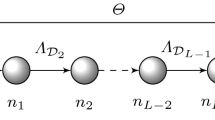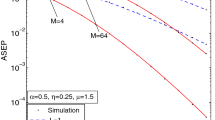Abstract
In wireless communication channels, the performance of the wireless communication systems deteriorate due to the severe influence of interference, multipath fading, path loss, shadowing, and noise, respectively. In this paper, we investigate the performance of the system transmitting over correlated η–µ frequency selective fading channels in terms of average error rates. Based on moment generating function approach, closed form expressions for average error probabilities for the system are derived and represented in terms of Appell’s hypergeometric functions and Lauricella’s multivariate hypergeometric functions. In addition, probability density function based approach is employed to determine the formulae for average error probabilities of the system operating over correlated η–µ multipath fading channels. The numerical results reveal that, the effects of correlation, decaying power factor and signal constellation size can be reduced using frequency, spatial antennas and path diversities, respectively. Furthermore, we confirm the correctness of the analytical approaches through Monte Carlo simulation technique.










Similar content being viewed by others
References
Hara, S., & Prasad, R. (1997). Overview of multicarrier CDMA. IEEE Communications Magazine, 35(12), 126–133.
Yang, L.-L. (2009). Multicarrier communications. London: Wiley.
Wang, L. C., & Chang, C. W. (2006). On the performance of multicarrier DS CDMA with imperfect power control and variable spreading factors. IEEE Journal on Selected Areas in Communications, 24, 1154–1166.
Alamouti, S. M. (1998). A simple transmit diversity technique for wireless communications. IEEE Journal on Selected Areas in Commun., 16(8), 1451–1458.
Yang, L.-L., & Hanzo, L. (2000). Performance of broadband multicarrier DS-CDMA using space–time spreading-assisted transmit diversity. IEEE Transactions on Wireless Communications, 4(3), 885–894.
Wang, X., Yang, W., Tan, Z., & Cheng, S. (2005). Performance of space–time block-coded multicarrier DS-CDMA system in a multipath fading channel. In IEEE international symposium on microwave, antenna, propagation and EMC technologies for wireless communications, MAPE 2005 (Vol. 2, pp. 1551–1555).
Weiping, X., & Milstein, L. B. (2001). On the performance of multicarrier RAKE systems. IEEE Transactions on Communications, 49(10), 1812–1823.
Elnoubi, S. M., & Hashem A. A. (2008). Error rate performance of MC DS-CDMA systems over multiple-input-multiple-output Nakagami-m fading channel. In IEEE military communications conference, 2008. MILCOM 2008 (pp. 1–7).
Yang, L.-L. (2008). Performance of multiantenna multicarrier direct-sequence code division multiple access using orthogonal variable spreading factor codes-assisted space–time spreading in time-selective fading channels. IET Communications, 2, 708–719.
Peppas, K. P., Lazarakis, F., Zervos, T., Alexandridis, A., & Dangakis, K. (2010). Sum of non-identical independent squared η–μ variates and applications in the performance analysis of DS-CDMA systems. IEEE Transactions on Wireless Communications, 9(9), 2718–2723.
Yacoub, M. D. (2007). The κ–μ distribution and the η–μ distribution. IEEE Antennas and Propagation Magazine, 49(1), 68–81.
Vanganuru, K., & Annamalai, A. (2002). Performance evaluation of transmit diversity concepts for WCDMA in multipath fading channels. In IEEE 56th vehicular technology conference, 2002. Proceedings. VTC 2002-Fall. 2002 (Vol. 1, pp. 568–572).
James, O. M., Brahim, B. S., & Naufal, M. S. (2013). Capacity and error probability performance analysis for MIMO MC DS CDMA System in η–µ fading environment. International Journal of Electronics and Communications, 67, 269–281.
Xu, F., & Li, G. (2005) Performance analysis of MQAM for MIMO WCDMA systems in fading channels. In 2005 international conference on communications, circuits and systems, 2005. Proceedings (Vol. 1, pp. 207–210).
Annamalai, A., & Tellambura, C. (2001). Error rates for Nakagami-m fading multichannel reception of binary and M-ary signals. IEEE Transactions on Communications, 49(1), 58–68.
Scott, M., & Donald, C. (2012). Probability and random processes: With applications to signal processing and communications (2nd ed.). Burlington, VT: Elsevier Science.
Win, M. Z., Chrisikos, G., & Winters, J. H. (1999). Error probability for M-ary modulation in correlated Nakagami channels using maximal ratio combining. In 1999 IEEE military communications conference proceedings, 1999. MILCOM (Vol. 1, pp. 70–75).
Asghari, V., da Costa, D. B., & Aissa, S. (2010). Symbol error probability of rectangular QAM in MRC systems with correlated η–µ fading channels. IEEE Transactions on Vehicular Technology, 59(3), 1497–1503.
Gordon, L. S. (2011). Principles of mobile communication (3rd ed.). Berlin: Springer.
Emad, K. A., & Iman, M. S. (2001). Selection and MRC diversity for a DS/CDMA mobile radio system through Nakagami fading channels. Wireless Personal Communications, 16, 115–133.
John G (1955) Distribution of the maximum of the arithmetic mean of correlated random variables. The Annal of Mathematical Statistics, 26(2), 294–300.
Lombardo, P., Fedele, G., & Rao, M. M. (1999). MRC performance for binary signals in Nakagami fading with general branch correlation. IEEE Transactions on Communications, 47(1), 44–52.
Alouini, M. S., Abdi, A., & Kaveh, M. (2001). Sum of gamma variates and performance of wireless communication systems over Nakagami-fading channels. IEEE Transactions on Vehicular Technology, 50(6), 1471–1480.
Marvin, K. S., & Mohamed, S. A. (2005). Digital communications over fading channels (2nd ed.). London: Wiley.
Kuhn, V. (2006). Wireless communications over MIMO channels: Application to CDMA and multiple antennas systems. London: Wiley.
John, G. P. (2001). Digital communications (4th ed.). New York, NY: McGraw-Hill.
Lu, J., Tjhung, T. T., & Chai, C. C. (1998). Error probability performance of L-branch diversity reception of MQAM in Rayleigh fading. IEEE Transactions on Communications, 46(2), 179–181.
Yen, R. Y. (2006). A general moment generating function for MRC diversity over gaussian gain fading channels. Tamkang Journal of Science and Engineering, 19(4), 353–356.
Li, Wei., Hao, Z., & Gulliver, T. A. (2006). Capacity and error probability analysis of orthogonal space-time block codes over correlated Nakagami fading channels. IEEE Transactions on Wireless Communications, 5(9), 2408–2412.
Tolga, M. D., & Ali, G. (2007). Coding for MIMO communication systems. London: Wiley.
Gradshteyn, I. S., & Ryzhik, I. M. (2007). Table of integrals, series, and products, 7th edn. New York: Academic Press.
Yu, X., & Xu, D. (2010). Performance Analysis of space time coded CDMA system over Nakagami fading channels with perfect and imperfect CSI. Wireless Personal Communications, 62, 633–653.
Author information
Authors and Affiliations
Corresponding author
Appendices
Appendix 1
The MGF of the instantaneous SINR at the output of the RAKE receiver is derived in this appendix. The envelope (R) of the fading signal is modelled by η–µ fading distribution. Then, the random variable γ = ‖R 2‖ has the PDF of η–µ distribution. Hence, a set of NrMtULr variates of η–µ random variables is equivalent to a set of 2µ independent Gaussian random variable vectors with NrMtULr dimensions. Since the instantaneous signal to interference noise ratio is given as in (8a)
where \(R_{nmjli}^{2} = R_{nmjli}^{T} R_{nmjli} = X_{nmjli}^{T} X_{nmjli} + Y_{nmjli}^{T} Y_{nmjli}\), Xi1=nmjl = [Xi11, Xi12, …, Xi2µ]T where i 1 = nmjl = 1, 2, …, NrMtULr represent dependent inphase random variables. Hence, Xi1k are independent and identically distributed Gaussian random variables with zero mean and variance \(E[X_{i1k}^{2} ]\), k = 1, 2, …, 2µ. Similarly, Yi1=nmjl = [Yi11, Yi12, …, Yi12µ]T denote dependent quadrature random variables. Therefore, Yi1k are independent identically distributed Gaussian random variables with zero mean and variance \(E[Y_{i1k}^{2} ]\) [27]. Both are mutually independent Gaussian variables with \(E[X_{nmjli} ] = E[Y_{nmjli} ] = 0, E[X_{nmjli}^{2} ] = \rho_{x}^{2} , E[Y_{nmjli}^{2} ] = \rho_{y}^{2}\), µ is the number of clusters of multipath. Therefore, the instantaneous SINR can be rewritten as
Considering the inphase random variates \(X_{i1k}^{T} X_{i1k}\), similarly for quadrature random \(Y_{i1k}^{T} Y_{i1k}\). For the case of inphase random variates, we assume the arbitrary covariance matrix as Cxx, then we can form a scalar quadratic function of vector X, i.e., suppose \({\text{Z}} = {\mathbf{X}}_{nmli}^{T} B_{nmli} {\mathbf{X}}_{nmli}\), where Bnmli is a 2µ by 2µ matrix. Hence, the joint PDF of \([{\text{X}}_{\text{nmlil}}^{2} + {\text{X}}_{{{\text{nmli}}2}}^{2} + \cdots + X_{{{\text{nmli}}2\upmu}}^{2} ]\) is [16, 28]
Then, the MGF of Z is
where det denotes determinant. Therefore, for NrMtULr diversity branches, we have
Similarly, for Ynmil (quadrature Gaussian variates), we have
where D is the matrix. Therefore, overall MGF of instantaneous SINR at the RAKE receiver output is
Appendix 2
In this appendix, we provide some hints for the solutions of (31), (36), (43), and (48), respectively. We consider
Hence, we integrate using by parts
and dV = e −αγ dγ, then
and \(V = - \frac{1}{\alpha }e^{ - \alpha \gamma }\), then
We have to integrate the first integral by parts, yields
Therefore, the last two integrals are obtained from [29, 30, 31, Eq. (3.371)], again applying successive integration by parts to first integral, the general solution is given as
Next, we consider the integral given below
Then, let \(z = \sqrt {g\gamma }\) and \(\gamma = z^{2} /g,{\text{ d}}\gamma {\text{ = 2zdz/g}}\), we have
where k = α/g, then integrating by parts
and
Hence, from [31, Eq. (2.326.11)]
then the integral becomes
then considering the integral part
and putting
Then from [27, 32, 31, Eq. (6.455.1)], the solution is
Therefore, the expressions for G1 can be employed in (30), (35), while for both G1 and G2 in (42), and (47), respectively.
Rights and permissions
About this article
Cite this article
Amok, J.O.M., Saad, N.M. Performance Analysis of Multiantenna MC DS CDMA System Over Correlated η–µ Multipath Fading Channels. Wireless Pers Commun 89, 539–568 (2016). https://doi.org/10.1007/s11277-016-3288-7
Published:
Issue Date:
DOI: https://doi.org/10.1007/s11277-016-3288-7




